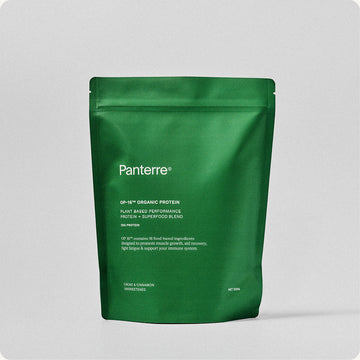This guide is about what makes a whey protein “best” - objectively - while focusing on organic whey: how it’s raised, how it’s made, and why the label and ingredient list matter as much as the macros.
What “best” actually means (beyond marketing)
When you strip away the noise, four things separate a bad whey from a great one:
-
Certification & provenance - how the milk is produced and verified
-
Feeding system - grass-fed vs. conventional and what that really implies
-
Composition that serves performance - complete amino acids, leucine, and form.
-
Short, clean ingredient list - avoiding unnecessary sweeteners, stabilisers, and fillers
Everything else - flavor, mixability, even price comes after these.
1) Organic status: what it guarantees (and why it matters)
Organic dairy rules are not just paperwork. In both the US and EU, organic standards prohibit growth-promoting hormones, forbid GMOs and ionizing radiation, restrict antibiotic use to therapeutic need only, and require pasture access/forage-based feeding as part of broader animal-welfare and environmental aims. In short: fewer synthetic inputs, tighter oversight, and a clearer chain of custody.
Why you care: If your recovery food is a daily habit, the farming system behind it matters - ethically and environmentally.
2) Grass-fed & provenance: more than a buzzword
“Grass-fed” signals a pasture-based system (with hay/silage in winter in the UK and EU). Large comparative datasets show milk from predominantly forage-fed cows carries a more favorable fatty-acid profile (higher omega-3s, better omega-6:omega-3 ratio, more CLA) than conventional milk. While whey powder removes most fat, grass-based systems still correlate with healthier starting milk and generally stronger animal-welfare and land-stewardship practices.
What provenance adds: Single-origin or fully traceable supply chains make it easier to verify how cows were raised, how the whey was filtered, and what (if anything) was added later.
3) Composition that actually helps you perform
Complete protein, rich in leucine
Whey is a complete protein with a naturally high leucine content - the amino acid most closely tied to triggering muscle protein synthesis (MPS). Multiple lines of evidence show 20–25 g whey typically provides ~2.2–3.0 g leucine, a level associated with robust post-exercise MPS.
Whey vs. other proteins
Classic work comparing whey, casein, and soy shows whey’s faster digestion and higher leucinemia translate to stronger acute MPS responses after training. That’s one reason athletes often favor whey in the recovery window.
Endurance outcomes: what the evidence says
Endurance-training meta-analysis: protein supplementation (various sources, commonly whey) has been shown to improve VO₂peak, increase lean mass, and enhance time-trial performance, though effects are modest and context-dependent. Newer reviews also tighten daily-intake guidance for endurance athletes (~1.8 g/kg/day, potentially higher during low-carb phases or rest days).
4) Ingredients to skip: the case for simple labels
Short ingredient lists aren’t about being fussy; they’re about safety and transparency.
Most mainstream protein powders lean heavily on artificial sweeteners like sucralose, aspartame, or acesulfame-K, plus stabilisers and gums to mask bitterness and improve shelf life. The result? A product that looks like a protein powder but reads more like a chemistry set.
And here’s the problem:
-
Gut health: Studies show certain sweeteners can disrupt the balance of the gut microbiome, potentially affecting metabolism and immunity.
-
Carcinogenic risk: In 2023, the International Agency for Research on Cancer (IARC) classified aspartame as “possibly carcinogenic to humans.” Others, like acesulfame-K, are under scrutiny for similar concerns.
-
Long-term uncertainty: While regulators often label these additives as “safe” within limits, many athletes consume them daily. The effects of chronic exposure, layered over years of training and supplementation, remain unclear.
For something as simple as a post-run recovery shake, why invite that risk?
How to pick the best organic whey (a field-tested checklist)
-
Look for real certifications
EU or Soil Association Organic logo. -
Confirm feeding system & origin
'Organic & grass-fed', single-origin, and traceable lots beat vague claims. Brands that can document pasture access and seasonal feeding are doing the hard work right. -
Choose the form that fits your gut & goals
Training hard and lactose-sensitive? Organic whey isolate. Want creamier smoothies and don’t mind a touch of lactose? Organic concentrate. -
Scan for dose & leucine
One serving delivering 20–25 g protein typically yields ~2.2–3.0 g leucine - a smart target post-session. -
Favor short labels
Ideally: 'organic whey protein' + maybe organic cocoa/vanilla. Skip sprawling lists of sweeteners, gums and emulsifiers.
A few evidence-based notes for athletes
-
Daily protein matters most. Endurance athletes often land well at ~1.6–2 g/kg/day.
-
Post-workout is still practical. Not a magic 30-minute window - but a 20–25 g serve soon after a hard session is an easy way to support repair.
-
Expect “modest but meaningful.” Meta-analyses report small improvements in aerobic capacity and performance; some single trials see no extra benefit when carbs are dialed in. Program, diet, and timing matter.
Bottom line
If you want the best whey protein powder, start with organic. It underwrites a cleaner supply chain - no growth hormones, GMO feed, or routine antibiotics, stronger animal-welfare rules, and better land practices.
It’s worth remembering: whey itself is not an ultra-processed food (UPF). It only becomes one when manufacturers load it up with artificial sweeteners, stabilisers, gums, and other additives designed for cost-cutting or shelf-life - not for your health. Choosing an organic whey protein with nothing more than “whey” and maybe organic cocoa or vanilla keeps it UPF-free, clean, and functional.



